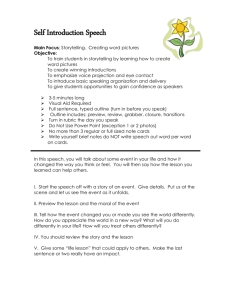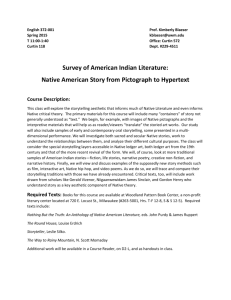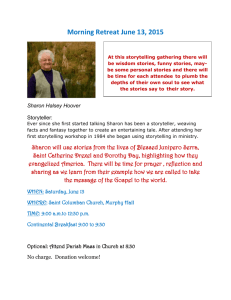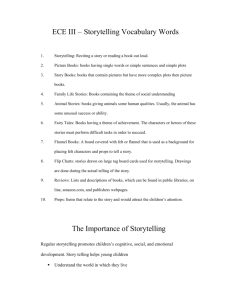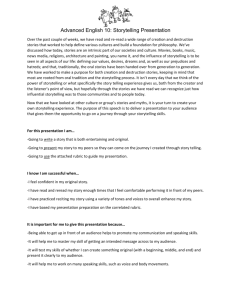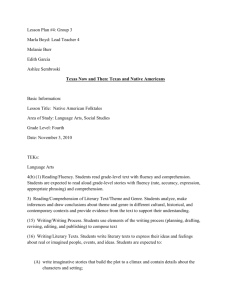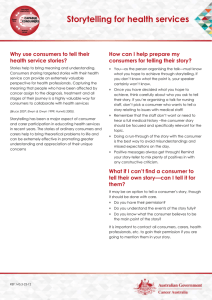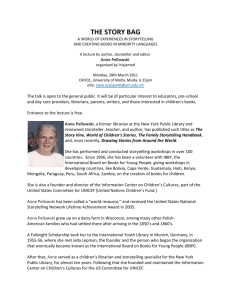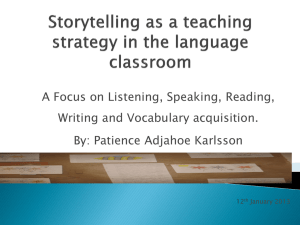DIGITAL STORYTELLING TO ASSESS WRITING SKILLS OF EFL
advertisement
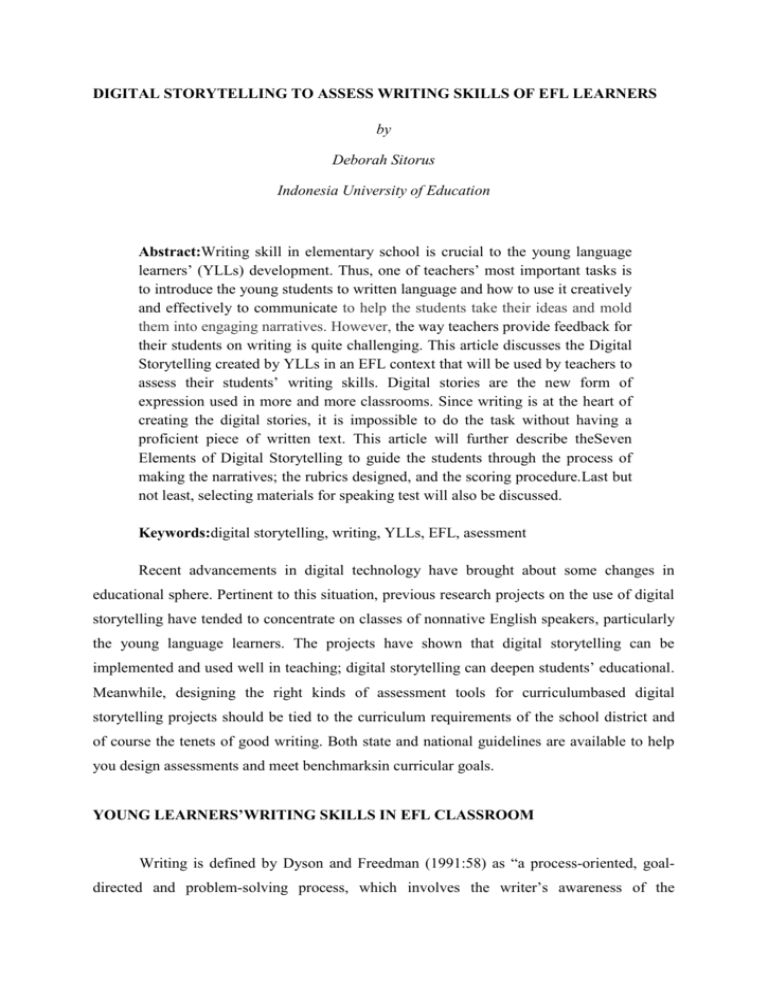
DIGITAL STORYTELLING TO ASSESS WRITING SKILLS OF EFL LEARNERS by Deborah Sitorus Indonesia University of Education Abstract:Writing skill in elementary school is crucial to the young language learners’ (YLLs) development. Thus, one of teachers’ most important tasks is to introduce the young students to written language and how to use it creatively and effectively to communicate to help the students take their ideas and mold them into engaging narratives. However, the way teachers provide feedback for their students on writing is quite challenging. This article discusses the Digital Storytelling created by YLLs in an EFL context that will be used by teachers to assess their students’ writing skills. Digital stories are the new form of expression used in more and more classrooms. Since writing is at the heart of creating the digital stories, it is impossible to do the task without having a proficient piece of written text. This article will further describe theSeven Elements of Digital Storytelling to guide the students through the process of making the narratives; the rubrics designed, and the scoring procedure.Last but not least, selecting materials for speaking test will also be discussed. Keywords:digital storytelling, writing, YLLs, EFL, asessment Recent advancements in digital technology have brought about some changes in educational sphere. Pertinent to this situation, previous research projects on the use of digital storytelling have tended to concentrate on classes of nonnative English speakers, particularly the young language learners. The projects have shown that digital storytelling can be implemented and used well in teaching; digital storytelling can deepen students’ educational. Meanwhile, designing the right kinds of assessment tools for curriculumbased digital storytelling projects should be tied to the curriculum requirements of the school district and of course the tenets of good writing. Both state and national guidelines are available to help you design assessments and meet benchmarksin curricular goals. YOUNG LEARNERS’WRITING SKILLS IN EFL CLASSROOM Writing is defined by Dyson and Freedman (1991:58) as “a process-oriented, goaldirected and problem-solving process, which involves the writer’s awareness of the composing process and the teacher’s or peer’s intervention at any time needed”. On the other hand, Susser (1994:39) defines writing as “a recursive, non-linear cognitive process in which the writer moves back and forth between prewriting-idea generating, writing, revising and editing until he/she is satisfied with his/her creation.” Pinter (2006), based on his study which analyzedthe YLLs’ writing skills in the EFL classroom claims that writing can be a useful skill in TEYL (Teaching English to Young Learners) provided that children are the ones who are ready and interested in the process of familiarizing themselves with the English writing system. He also suggested effective ways to teach foreign language writing. Writing is a complex task in which children progress from the level of copying familiar structures up to recognizing text structures, so he claims that there is no effective formula to teach young children writing, not even the ones who have English as their mother tongue (L1) or those how have English as a second language (L2). Whether writing is introduced in the child’s curriculum depends on many factors suchas the age of the kids, the level of exposure to English, and their ability to write in their first language. The process of learning how to write in English is a complex one and usually takes a long time to acquire. This is because in English, the letter and sound correspondences are not at all direct and consistent. Therefore, English is said to have a ‘deep’ language orthography since, in English, how the words are pronounced does not always help to work out how this word is actually written. In order to teach those irregularities of sounds of the English language, all children are taught letter-sound correspondences at school so that, when they face with a piece of writing, they know which letter corresponds to a given sound. Depending on the English foreign language learner’s background, together with the writing system in their first language, children will need more or less practice with the mechanical basis of English writing. In order to make these first activities fun for the EFL learner, teachers can introduce a creative copying activity, in which the students select which words to copy from a given list and then, add one on their own.However, in most contexts, students use a course book and an activity book that contain both written grammatical and vocabulary exercises at word or sentence level, which will contribute to practising writing using familiar language structures. Children begin very early to write basic words from their environment such as ‘mummy’, ‘daddy’ or a friend’s/sibling’s name, since they first will begin to understand that messages, stories, names, etc, can be represented on a piece of paper by means of symbols, which are, of course, the letters. On the other hand, many teachers use guided writing, which means that children should complete some kind of model writing with their ideas and relevant information. Usually, these types of activities involve writing in form of cards, invitations, letters, posters or even stories. This will allow the children to be aware that we write differently depending on whom we are writing to/for. Guided writing activities can be innovating because they allow children to expand more in their writing and therefore, they will probably write longer texts. Children of all ages are the best story-lovers. Stories of different natures are told to children from their early childhood. This makes them wantto be engaged in their own learning and inspired to develop their skills and talents to write their own stories. According to Ruth Wajnryb (2003), a story can be used in many different ways: It can help to practice both speaking and writing skills in a context which is deeply engaging and personalized; to encourage group sharing, team-building, and co-operative text-making; as opportunities to develop oral fluency and confidence; for specific language practice of tenses, descriptive adjectives, reporting verbs, and punctuation for direct speech; for development of extensive writing that includes narrative, description, dialogue, and character development. In this case, teachers should be interested in identifying what students can do while writing, also, in assessing their ability and knowledge when writing, and one of the most important parts, in giving correct feedback to the student and helping him/her to develop the writing strategies and their correspondent subskills, since research has indicated that the use of appropriate strategies can result in achievement in specific skill areas (Oxford et al., 1993). WRITING SKILLS ASSESSMENT TO YOUNG LEARNERS There are various writing activities used by teachers to assess the students. For example, they are asked to complete some kind of model writing with their ideas and relevant information. Usually, these types of activities involve writing in form of cards, invitations, letters, stories or even posters.Children learn best when they know what’s expected of them when they are learning, get feedback on how well they are doing in their learning, understand what they can improve on and how they can do this. Good common sense really. But how can this be done? The guidelines explore self-assessment as one method teachers can use to help children learn. Self-assessment basically involves children looking at their own work in a reflective way, identifying parts that are good and parts that perhaps are not so good and could be improved, and then deciding how they might do the work differently the next time in order to improve it. The teacher can use many different tools to help children develop selfassessment skills. One of these is rubrics. A rubric describes varying levels of quality in a piece of work. It has two main features: (1) a list of criteria, giving the important elements of the work. (2) a set of statements which describe different levels of quality in the work. The combination of these two elements of the rubric helps to build up a picture for the teacher and the learner of whatsuccess will ‘look like’ in the activity or piece of work. Rubrics can also be used with younger children. In this case, faces or other symbols might be used to show ‘levels of satisfaction’. Young children can be helped to assess their own work by talking about what they have done, saying whether they are pleased with it, what they like or don’t like about it, or what they would like to do better in it next time. The example of narrative writing rubrics is provided in the appendix. DIGITAL STORIES TO ASSESS YOUNG LEARNERS’ WRITING SKILLS Multimedia has become more appealing in the teaching and learning process, as it is interactive and encouraging. New advancement in technology usually arouses students’ curiosity and, in turn, increases their motivation. Rosmalina (2012) stated that digital storytelling has emerged over the last few years as a powerful teaching and learning tool that engages both teachers and their students. Digital storytelling as it is defined in the work of Banaszewski (2005) is the practice of combining personal narrative with multimedia (images, audio, and text) to produce a short autobiographical movie.De Craene (2006:1) rightly pointsout that digital storytelling can assist teachers to manage their classes: digital storytelling is helpful not only as a teaching technique but also for classroom management. A confident opinion on digital storytelling has been expressed by Porter (2008:7). He says storytelling builds 21st century communication skills: creativity and inventive thinking, multiple intelligences, higher-order thinking (lessons learned), information literacy, visual literacy, sound literacy, technical literacy, effective communication (oral, written and digital), teamwork and collaboration, project managements, and enduring understandings. Studies also suggest the importance of writing in digital storytelling, since "it is the patient development of ideas with pen and paper or keyboard that bring the story to life" (Maier, 179). Ohler (2005/2006) argues that "writing is key," noting that students must first develop written scripts and storyboards before working with the technology. Although the written form of a digital story may not require the same "polish" as that of a story meant for the page, students cannot simply start a digital story without a clear understanding of its structure and purpose. Digital storytelling helps develop a range of digital communication styles necessary to function in a knowledge society. It also facilitates the convergence of four student-centered learning strategies: student engagement, reflection for deep learning, project based learning, and the effective integration of technology into instruction. Figure 1. Convergence of Student-Centered Learning Strategies The writing process is a complex task that is developed over many years.Both reluctant and proficient writers will find the digital story interesting. Thestudent’s written story will move beyond paper and pencil and become a livingpiece of art including the student’s voice, a soundtrack, and a series of images(photos and/or drawings).When guiding students through this process, teachers may want to follow the Seven Elements of Digital Storytelling outlined on (http://www.storycenter.org/). the Center for Digital Storytelling Website Seven Elements of Digital Storytelling 1. Point of View Teachers must help students understand that they can approach a story from various points of view. Teachers can model different storytelling techniques, and also share examples of published literature that is written from different perspectives. A digitalstory should be personal, and illustrate a passion of the student. 2. A Dramatic Question What is the central message of the digital story? Teachers must assist students in the art of keeping their audience engaged by helping them define a dramatic question. The dramatic question can be stated in thetext for young writers; as the writerbecomes more sophisticated, the dramatic question may be implied through the actions of the story. 3. Emotional Content Most powerful stories contain some content that causes the reader to feel joy, sadness, excitement or another emotion. The student’s digital story is generally about a person, place or experience that has had a profound impact on his or her life. Thus, teachers must encourage students to share the emotions they experienced in their stories, so others can understand why events are important to them. 4. The Gift of Voice When students hear their own voice on a recording, sometimes they are embarrassed, or they may not even recognize their own voice. Recording the author’s voice telling the story is a key element. Teachers must encourage the students to practice and record their narration numerous times, experimenting with the pacing and intonation to see how it can change the context of the message. Teachers also must guide students away from simply reading their text. One technique suggested on the Website is to construct the voice recording by editing and piecing together the contents of an interview about the events of the story. This may help thestudents speak from their heart. A conversational tone of voice is generated through the interview since they are talking to a real person, instead of a computer or microphone. One thing to remember is that if multiple recordings of the story are taken, the best parts of each recording can be edited together to create the final recording. 5. The Power of the Soundtrack Music invokes all sorts of emotions.By choosing the right soundtrack, students can help their audience understand the emotions they experienced during the event. Students are drawn to popular music since that is what they listen to. However, teachers mustbe aware of fair use policies and copyright issues. Students have the right to use popular music for a class project with their peers as an audience. If the stories will be shared with a larger audience such as on a school Website, students should choose royalty-free music or compose their own. Students can compose their own music using Apple’s GarageBand (http://www.apple.com/ilife/garageband/) or Sony’s Super Duper Music Looper (http://www.sonymediasoftware.com/products/ showproduct.asp?PID=535) for the PC. There are a number of royalty-freemusic resources if you do not have thetime or technology to compose your own soundtracks. Web resources for royalty-free music: Soundzabound (http://www.soundzabound.com/) Sounddogs (http://www.sounddogs.com/) 6. Economy One thing to keep in mind is that the event or personthat a student chooses for the subject of their digital story is quite important to this child. Therefore, they probably have volumes of information, stories and anecdotes to share. Teachers try to help the students focus on the centralpurpose for the story, and assist them in choosing the best pictures and most important pieces of the narrative to tell the story. Limiting the total time of the movie and the number of pictures used may seem like you are infringing upon their creative liberties, but teacherswill be doing the students a favor by forcing them to be selective as to what makes the final cut. 7. Pacing How will the students keep theiraudience engaged? Pacing may be the key to making a good story great. When students record their narrative, they should be aware that the pace at which they speak makes a difference. Sometimes leaving silence can be a strategy to let the listener linger on the thought that was just shared, or the silence can create suspense leading up to the next sequence of narration. Teachers must help the student understand thatthere are many ways to express their story and have them experiment with different pacing variations to see which one fits their story the best. Digital Storytelling is a potent tool for students who are taught to create their own stories. After viewing example digital stories created by their teachers or other story developers, students may be given assignments in which they are first asked to research a topic and then choose a particular point of view and, as described in the Seven Elements of Digital Storytelling, a dramatic question. This type of activity can generate interest, attention and motivation for the "digital generation" students in today’s classrooms. The process can capitalize on the creative talents of students as they begin to research and tell stories of their own as they learn to use the library and the Internet to research rich, deep content while analyzing and synthesizing a wide range of content. In addition, students who participate in the creation of digital stories may develop enhanced communications skills by learning to organize their ideas, ask questions, express opinions, and construct narratives. It also can help students as they learn to create stories for an audience, and present their ideas and knowledge in an individual and meaningful way. ASSESSING A DIGITAL STORY WRITING Ohler (2006) says that the use of digital storytelling places us within "...two very powerful models: storytelling, with its powerful ability to engage and teach students, and critical thinking, with its ability to turn students into thinking, reflective people, consumers, voters’ … and that by blending the two, we can offer a ‘powerful pedagogy’...". When presenting digital stories, and viewing the stories of others, students gain confidence in their own abilities. This promotes social learning; by adding a group component, students are introduced to collaborative brainstorming, designing and creating the digital story.On developing digital stories, students can reflect on whether its assessment should be summative or formative. These two assessments are interconnected, each rarely standing alone. Sanders says that “...the current educational system is heavily biased towards textbased assignments and the use of a multimedia digital artifact is unlikely to be acceptable for summative assessment...” It is important for students to understand the criteria that will be used toassess their digital story before they start. Rubrics clearly define the expectations of the assignment. Provide each student with a copy of the rubric at the beginning of the project. They should keep it handy so it can be referred to throughout the creation process. The rubric allows students to envision a range of possibilities for their story. Teacher can create hisown rubric at Rubistar (http://rubistar.4teachers.org/). Or better yet, ask ther students to share the criteria that they look for in an interesting digital story and compose the rubric together. The rubric should assess a broad range of skills that the students exhibit from the beginning of the task until the end. Teachers must be careful to avoid only assessing the final product because each student has different talents, and the process that was followed should be recognized as well. The rubric should assess the writing process aswell as the technology used to create the digital story. Teachers will notice that the following sample rubrics contain the Seven Elements of Digital Storytelling. If teachers are interested in creatinghis own rubric, this may be a good place to start. Teachers themselves may also be able to modify one of the sample rubrics to meet their individual classroom needs. Figure 2 Digital Story writing in form of script MATERIALS SELECTION Selecting the appropriate stories for children to create the digital story is the first and most important dimension of digital storytelling.The wide array of stories might include fiction, folktales, myths, legends, and other narratives. The storymust appeal to the teller, inspiring interest in the commitment to do what is necessary to bring the story to life. Young learners are more interested to children’s adventure stories, folktales, legends, fables, fantasy, realistic fiction, and myth or the subgenres of adventure stories, historical fiction, mysteries, myths, science fiction, or realistic fiction. It is th teachers’s role to select the appropriate materials based on their students interest in order to make the students enjoy doing the tasks. Digital storytelling provides a truly engaging learning experience which blends writing, technology and emotion to create a compelling product of value. This process is one that students can use throughout entire lives to tell their stories. CONCLUSION Creating digital stories is a perfect opportunity to engage students in media literacy, especially writing, in learning about how the media influence our perceptions of the world (Goodman, 2003; Tyner, 1998). Stories are enjoyable because we give ourselves over to them. Digital stories provide powerful media literacy learning opportunities because students are involved in the creation and analysis of the media in which they are immersed. Meanwhile, designing the right kinds of assessment tools for curriculumbased digital storytelling projects should be tied to the curriculum requirements of the school district and of course the tenets of good writing. Both state and national guidelines are available to help you design assessments and meet benchmarksin curricular goals. Another thing to consider is if the teachers want to assess and score the students dital story, they have to notice that the following sample rubrics contain the Seven Elements of Digital Storytelling. The use of the rubrics is very helpful since children can be helped to assess their own work by talking about what they have done, saying whether they are pleased with it, what they like or don’t like about it, or what they would like to do better in it next time. REFERENCES Banaszewski, T. M., (2005). Digital Storytelling: Supporting Digital Literacy in Grades 4-12. Georgia: Georgia Institute of Technology. Print. Center for Digital Storytelling Website (2005) http://www.storycenter.org/history.html(accessed on December 22, 2013) De Craine, M. M. (2006). Using & Teaching Educational Technology, Digital Storytelling: A Practical Classroom Management Strategy, (Online), (http://terryfreedman. org.uk/artman/publish/printer_804.php accessed on December 22, 2013). Dyson, A and Freedman, S. (1991). Handbook of Research on Teaching in the Language Arts. New York: MacMillan. Goodman, S. (2003). Teaching youth media: A critical guide to literacy, video production & social change. New York: Teachers College Press. Maier, Robert Brick and Mercedes Fisher. (2006-2007). Strategies for Digital Storytelling via Tabletop Video: Building Decision Making Skills in Middle School Students in Marginalized Communities. Journal of Educational Technology Systems, 35(2), 175192. Ohler, Jason. (December 2005/January 2006). The World of Digital Storytelling [Electronic version]. Educational Leadership, 63(4), 44-47. Oxford, R., Park-Oh, Y., Ito, S. and Sumrall, M. (1993). “Learning a language by satellite: What influences achievement?”. System, 21,31-48. Pinter, A.M. (2006) “Teaching reading and writing” In A.M. Pinter, Teaching Young Language Learners. United Kingdom: Oxford University Press, 74-77. Porter, B. (2008). Digital Storytelling, (Online), (http://www.DigitTales.us accessed on December 22, 2013). Rosmalina, I. (2012). Digital Storytelling: Using Technology to Improve Language Skills of EFL Learners at an Indonesian, (online), (http://conference.pixelonline.net/ICT4LL2012/common/download/Abstract_pdf/224-IBT89-ABSRosmalina-ICT2012.pdf accessed on December 22, 2013) Sandars J, Murray C, Pellow A. (2008).Twelve tips for using digital storytelling to promote reflective learning. Med Teach. 30:774–7. Susser, B. (1994). “Process approaches in ESL/EFL writing instruction”. Journal of Second Language Writing, 3, 31-47. Tyner, K. (1998). Literacy in a digital world: Teaching and learning in the age of information. Mahwah, NJ: Erlbaum. Wajnryb, R. (2003). Stories: narrative activities for the language classroom. Cambridge: Cambridge University Press. Print. APPENDIX I DIGITAL STORY RUBRICS APPENDIX II NARRATIVE STORY RUBRIC
